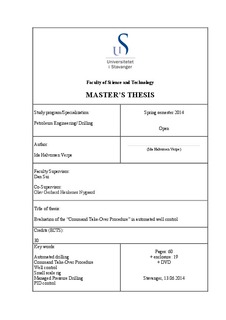| dc.contributor.author | Verpe, Ida Halvorsen | |
| dc.date.accessioned | 2014-09-22T13:48:19Z | |
| dc.date.available | 2014-09-22T13:48:19Z | |
| dc.date.issued | 2014-06-13 | |
| dc.identifier.uri | http://hdl.handle.net/11250/220986 | |
| dc.description | Master's thesis in Petroleum engineering | nb_NO |
| dc.description.abstract | The growing need for new technology in the pursuit of oil is creating new challenges
related to well control. Drilling in HPHT (High Pressure High Temperature)
reservoirs, arctic areas, and depleted zones might imply that the drilling window
between the pore pressure and the fracturing pressure is narrow. This presents
challenges in terms of gas influx. As of today kick handling is a manual procedure
with the driller in charge.
Automation of well control procedures can be the solution to several problems related
to kick detection and kick handling. This thesis introduces theory about conventional
well control as well as control theory and automated well control. A part of the work
was experimental, and was performed at a simplified rig model at the two-phase
laboratory at the University of Stavanger. The results are presented in chapter 6.
The main focus in the experimental part is on the Command Take-over procedure.
Several experiments were performed leading to the main experiment. The main
principle of this procedure is that the drilling operation is run in MPD (Managed
Pressure Drilling) mode with a PI-controller (Proportional Integral controller) on the
MPD valve. When a gas kick occurs, the WCV (Well Control Valve) mode is
activated with a PI-controller on the WCV. Further the BOP (Blow Out Preventer) is
closed and the kick is circulated out of the well through the WCV. After the
circulation, the operation is back to MPD mode, and the operation continues as
planned.
The results show that the Command Take-Over Procedure is feasible on actual
drilling rigs. It is further possible to assume that the procedure is safer, because the
procedure is automated, without the dependence of human judgement and ability to
make good decisions in well control incidents. However, it is important to have a
drilling crew available on the rig in case of mechanical failure. The procedure is also
more efficient and time saving since the pump are constantly running during the
procedure, and there might not be a need for a new mud with higher density to regain
well control after a gas kick. | nb_NO |
| dc.language.iso | eng | nb_NO |
| dc.publisher | University of Stavanger, Norway | nb_NO |
| dc.subject | petroleumsteknologi | nb_NO |
| dc.subject | boreteknologi | nb_NO |
| dc.subject | automated drilling | nb_NO |
| dc.subject | managed pressure drilling | nb_NO |
| dc.subject | MPD | nb_NO |
| dc.title | Evaluation of the “Command Take-Over Procedure” in automated well control | nb_NO |
| dc.type | Master thesis | nb_NO |
| dc.subject.nsi | VDP::Technology: 500::Rock and petroleum disciplines: 510::Petroleum engineering: 512 | nb_NO |
| dc.source.pagenumber | 79 | nb_NO |
